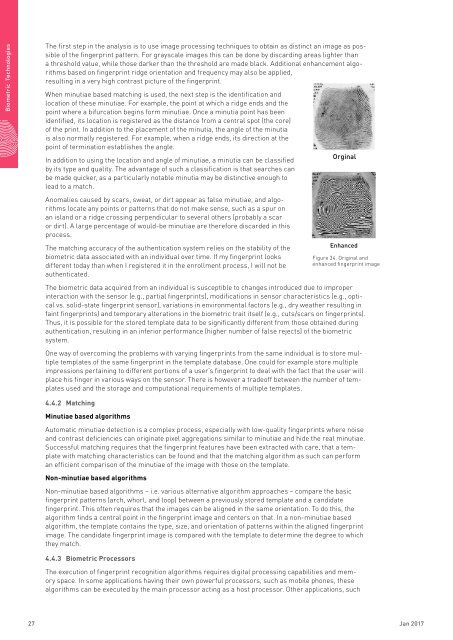BIOMETRIC
Fingerprints-Biometric-Technologies-Whitepaper-January-2017-RevB
Fingerprints-Biometric-Technologies-Whitepaper-January-2017-RevB
You also want an ePaper? Increase the reach of your titles
YUMPU automatically turns print PDFs into web optimized ePapers that Google loves.
Biometric Technologies<br />
The first step in the analysis is to use image processing techniques to obtain as distinct an image as possible<br />
of the fingerprint pattern. For grayscale images this can be done by discarding areas lighter than<br />
a threshold value, while those darker than the threshold are made black. Additional enhancement algorithms<br />
based on fingerprint ridge orientation and frequency may also be applied,<br />
resulting in a very high contrast picture of the fingerprint.<br />
When minutiae based matching is used, the next step is the identification and<br />
location of these minutiae. For example, the point at which a ridge ends and the<br />
point where a bifurcation begins form minutiae. Once a minutia point has been<br />
identified, its location is registered as the distance from a central spot (the core)<br />
of the print. In addition to the placement of the minutia, the angle of the minutia<br />
is also normally registered. For example, when a ridge ends, its direction at the<br />
point of termination establishes the angle.<br />
In addition to using the location and angle of minutiae, a minutia can be classified<br />
by its type and quality. The advantage of such a classification is that searches can<br />
be made quicker, as a particularly notable minutia may be distinctive enough to<br />
lead to a match.<br />
Anomalies caused by scars, sweat, or dirt appear as false minutiae, and algorithms<br />
locate any points or patterns that do not make sense, such as a spur on<br />
an island or a ridge crossing perpendicular to several others (probably a scar<br />
or dirt). A large percentage of would-be minutiae are therefore discarded in this<br />
process.<br />
The matching accuracy of the authentication system relies on the stability of the<br />
biometric data associated with an individual over time. If my fingerprint looks<br />
different today than when I registered it in the enrollment process, I will not be<br />
authenticated.<br />
Orginal<br />
Enhanced<br />
Figure 34. Original and<br />
enhanced fingerprint image<br />
The biometric data acquired from an individual is susceptible to changes introduced due to improper<br />
interaction with the sensor (e.g., partial fingerprints), modifications in sensor characteristics (e.g., optical<br />
vs. solid-state fingerprint sensor), variations in environmental factors (e.g., dry weather resulting in<br />
faint fingerprints) and temporary alterations in the biometric trait itself (e.g., cuts/scars on fingerprints).<br />
Thus, it is possible for the stored template data to be significantly different from those obtained during<br />
authentication, resulting in an inferior performance (higher number of false rejects) of the biometric<br />
system.<br />
One way of overcoming the problems with varying fingerprints from the same individual is to store multiple<br />
templates of the same fingerprint in the template database. One could for example store multiple<br />
impressions pertaining to different portions of a user’s fingerprint to deal with the fact that the user will<br />
place his finger in various ways on the sensor. There is however a tradeoff between the number of templates<br />
used and the storage and computational requirements of multiple templates.<br />
4.4.2 Matching<br />
Minutiae based algorithms<br />
Automatic minutiae detection is a complex process, especially with low-quality fingerprints where noise<br />
and contrast deficiencies can originate pixel aggregations similar to minutiae and hide the real minutiae.<br />
Successful matching requires that the fingerprint features have been extracted with care, that a template<br />
with matching characteristics can be found and that the matching algorithm as such can perform<br />
an efficient comparison of the minutiae of the image with those on the template.<br />
Non-minutiae based algorithms<br />
Non-minutiae based algorithms – i.e. various alternative algorithm approaches – compare the basic<br />
fingerprint patterns (arch, whorl, and loop) between a previously stored template and a candidate<br />
fingerprint. This often requires that the images can be aligned in the same orientation. To do this, the<br />
algorithm finds a central point in the fingerprint image and centers on that. In a non-minutiae based<br />
algorithm, the template contains the type, size, and orientation of patterns within the aligned fingerprint<br />
image. The candidate fingerprint image is compared with the template to determine the degree to which<br />
they match.<br />
4.4.3 Biometric Processors<br />
The execution of fingerprint recognition algorithms requires digital processing capabilities and memory<br />
space. In some applications having their own powerful processors, such as mobile phones, these<br />
algorithms can be executed by the main processor acting as a host processor. Other applications, such<br />
27 Jan 2017


